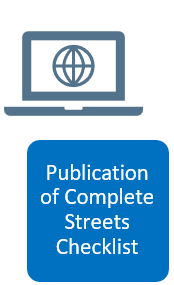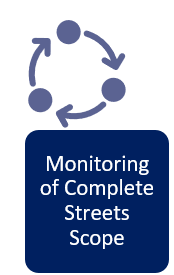1.2 A Complete Streets Approach
Vision
“Seattle is a thriving, equitable community powered by dependable transportation.”
To support this vision, we seek to create and maintain safe streets for everyone. We do this by using a complete streets approach.
The Seattle Department of Transportation (SDOT) uses a rigorous, data-driven process to develop complete streets – streets that are designed for people who walk, bike, ride transit and people of all ages and abilities – while promoting safe operation for all users, including cars and freight. We lead with equity during the project prioritization process and evaluate planned projects consistent with the Complete Streets Ordinance 122386 and accompanying policy language. This is the lens through which SDOT views all of our projects during a project’s complete streets assessment in the early stages of the 0-30% design phase, with a goal of identifying specific improvements that can be incorporated into a project to balance the needs of all users.
Process
1.  |
The Project Developer initiates the Complete Streets Checklist, which summarizes data and information about the streets and surroundings, as well as the details of the proposed project, with a goal of identifying specific improvements that can be incorporated into the project. Compilation and analysis of this data is aided by use of a GIS-based Complete Streets Story Map and through initial discussions with Program Owners and Subject Matter Experts (Complete Streets reviewers). These discussions are furthered for all reviewers at the project kick-off meeting. |
 |
|
2.  |
Complete Streets Program Owners and Subject Matter Experts (SMEs) review the proposed project scope for opportunities or conflicts based on the information provided by the project developer. If Program Owners want to partner to add scope to the project, this is the window for adding funded scope to the project. If Program Owners identify unfunded needs, this is also the window to highlight them by providing recommendations and preliminary cost estimates to be included in the checklist. |
3.  |
The Project Developer sends the draft Complete Streets Checklist to all reviewers. Program Owners and Subject Matter Experts review the draft Checklist prior to the Project Definition Sign Off briefing. Review comments should be addressed/resolved prior to Project Definition Sign Off briefing, or raised as an outstanding issue at the briefing. |
4.  |
The Project Developer[1] and Project Manager[2] brief the Program Owners and Subject Matter Experts on the final Complete Streets Checklist and obtain approval from the Project Definition Sign Off group (involved in the Complete Streets Checklist process) on which recommendations from the Complete Streets Checklist will be included in the project scope of work. If there is a lack of agreement amongst the project staff, there is an escalation process to elevate decisions to the Complete Streets Steering Committee (comprised of Division Directors) for resolution. Once signed off on, this is the scope of work that should be carried to 30% design. The Project Developer prepares a Project Definition Memo, which outlines project purpose and desired outcomes, as well as the finalized scope, including information on which Complete Streets recommended scope elements have been included and which recommended scope elements have not been included. The Complete Streets Checklist and Project Definition Memo should be completed / signed after selection of a preferred alternative and prior to initiation of the 30% design plans.
[1] Project Developer: The Project Developer defines the project scope through alternatives analyses and a thorough Complete Streets process while also considering the community’s input. The Project Developer includes scope from potentially multiple Program Owners, and is responsible for ensuring that the ultimate project scope aligns with the Program Owner’s high level scope. [2] Project Manager: The Project Manager manages the team and scope, schedule and budget for the project. The Project Manager aligns the project’s goals with the realities of schedule and budget while also considering the community’s input. |
5.  |
Following the 30% project baseline, the signed Complete Streets Checklist should be posted to the project website to provide transparency in how project needs and opportunities were assessed and what the final scope decisions were. |
6.  |
Project Manager verifies project scope consistency with the Complete Streets Checklist at 30/60/90/100% design milestones. Project Engineers check against the finalized Complete Street Checklist / Project Scope Definition Memo when filling out the Capital Improvement Program (CIP) Accomplishment Checklist at 30% design and construction advertisement. Project Manager checks against the Complete Streets Checklist / Project Definition memo when significant scope changes occur and circles back with the Project Development division, Policy & Planning division, and any affected Program Owners / Subject Matter Experts. If a Complete Streets scope element ultimately cannot be included in the project scope due to scope changes post 30%, the project should return to the Project Definition Sign Off group for the scope change briefing and approval. |
Performance Metrics
SDOT collects performance metrics for each of the modes listed below to gauge our success in meeting the complete streets goal – to design streets for people who walk, bike, and ride transit, and all ages and abilities, while promoting safe operations across our citywide network. In addition to these metrics, we also want to know if we are improving the user’s experience and, in turn, helping to meet our modal targets.
By providing best practice multimodal facilities that users of all ages, abilities, incomes, and races can safely and affordably use, we are meeting our complete streets vision.
Pedestrian
- Number of fatality/serious injuries reduced from previous years
- Rate of crashes involving pedestrians, reported both by pedestrian crashes per 100,000 residents and pedestrian crashes per pedestrian trips
- Number of safety spot improvements
- Percent of sidewalks within the Priority Investment Network completed
- Mode share (percentage of trips made on foot as measured in the Puget Sound Regional Council’s Household Travel Survey)
- Pedestrian activity (number of pedestrians in selected count locations)
- Increase percentage of children walking or biking to or from school
Transit
- Percent of households within a 10-minute walk to 10-minute or better transit service
- Current status: 70% (up from 25% in 2015)
- 2020 Goal: 53%
- 2025 Goal: 72%
- Ridership change
- Transit spot improvements completed per year
- Target: 20/ year
- Tracked through Levy to Move Seattle reporting
- Percent of urban village transit routes with a 10-minute or better service
Bicycle
- Bicycle facility miles delivered broken down by facility type
- Bicycle facility spot improvements
- Bike parking spots installed
- Bicyclist serious crashes and fatalities
User Experience (Biannual Survey)
- Over the past few years, do you think that Seattle as a whole has gotten better, stayed the same, or gotten worse in the ability to get around in the following ways:
- Public transportation (e.g., buses, trains, light rail)
- Car
- Car share (e.g., Car2go, Zipcar)
- Bikeshare (e.g., Jump, Spin)
- Rideshare (e.g., Uber, Lyft)
- Walking
- Biking
- Moving freight (e.g., moving goods on large trucks)
- Over the past few years, do you think that your neighborhood has gotten better, stayed the same, or gotten worse in the ability to get around in the following ways:
- Public transportation (e.g., buses, trains, light rail)
- Car
- Car share (e.g., Car2go, Zipcar)
- Bikeshare (e.g., Limebike, Spin)
- Rideshare (e.g., Uber, Lyft)
- Walking
- Biking
- Moving freight (e.g., moving goods on large trucks)
- How satisfied are you with the job that SDOT does in building and maintaining each of the following facilities and services?
- Improving road conditions
- Adjusting signal timing to help traffic flow better
- Repairing and replacing aging or deteriorating bridges and overpasses
- Repairing sidewalks
- Adding new sidewalks
- Adding crosswalks for pedestrians
- Adding bike lanes
- Improving bike lanes
- Keeping traffic moving safely during and after snow and ice events
- Issuing construction permits, street improvements, and traffic control
- Expanding the number of buses and bus service
- Ensuring the fast and reliable movement of buses through bus lanes
- Improving bus stops (lighting, signage, information)
- How safe do you feel as a pedestrian while crossing intersections in the City?
- How safe do you feel biking in the city?
- How affordable do you feel transportation is in Seattle?
Tracking
Tracking is critical to monitoring our performance, relative to our Complete Streets vision.
During the initial 0-30% design process, the Project Developer inputs the Complete Street Checklist scope outlined in the signed final Complete Streets Checklist / Project Definition Memo into our Project Portfolio Management (PPM) system to capture 1) Complete Streets elements considered and included in the project and 2) Complete Streets elements considered but not included in the project.
After construction, the Complete Streets Program Owner checks assets that are actually built against what was agreed to in the Project Definition Memo signed prior to 30% design to “close the loop” on the Complete Street Checklist scope and identify potential complete streets process improvements.
